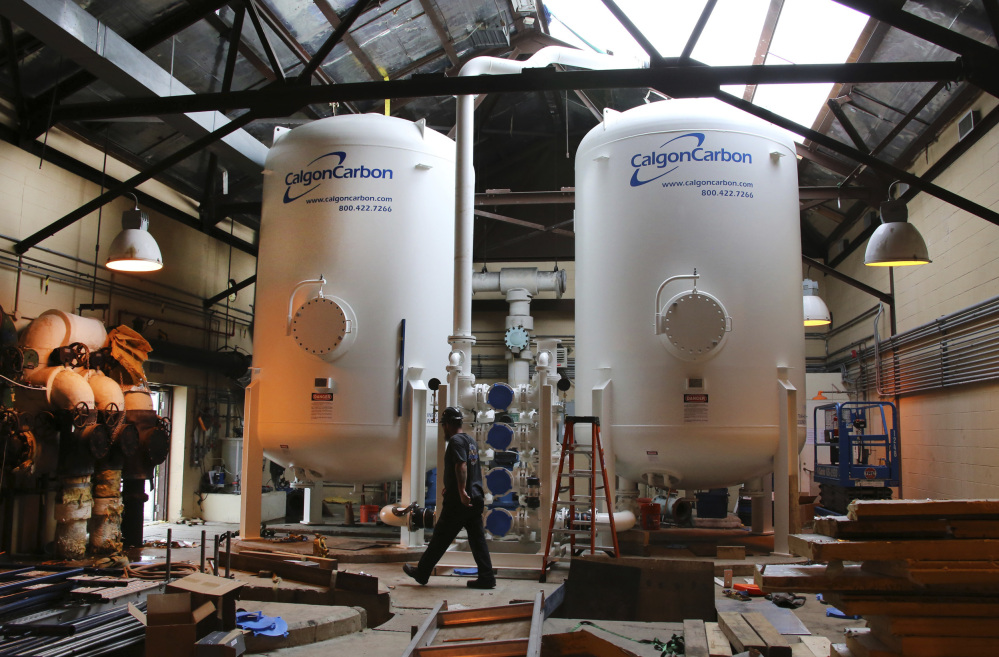PORTSMOUTH, N.H. — The Pease International Tradeport, which features an airport, hundreds of businesses and several day care centers, has been called a textbook example of how to redevelop an air base.
But many who worked or had their children looked after there are coming to terms with a hidden risk: drinking water contaminated by military firefighting foam that contained perfluorinated compounds, or PFCs.
Exposure to the chemicals, found in scores of everyday products like nonstick cookware and stain-resistant carpet and probably occurring at low levels in most people, have been linked in animal studies to low birth weight, accelerated puberty, cancer and thyroid problems, among other maladies, according to the Environmental Protection Agency.
But it’s far from clear how much those problems also manifest in humans. And the uncertainty isn’t sitting well with the Pease parents whose children were found to have elevated levels of PFCs in their blood.
Many, like Andrea Amico, Alayna Davis and Michelle Dalton, who formed the advocacy group Testing for Pease in 2015, said they have struggled to find doctors who can interpret the test results.
None of the three women can definitely say the exposure has been linked to health problems. Still, they wonder whether their children’s frequent fevers and infections might suggest the chemicals are affecting their immune systems.
“My son looks like a normal 4-year-old boy. He’s active. He loves everything that 4-year-old-boys love,” Dalton said. “But on the inside, it’s a different story. His body is constantly fighting.”
More worrisome, they said, is what the future holds for their children, since the chemicals can remain in the body for years.
“My concern is that their long-term health will be impacted by this significant exposure that they had as small children,” said Amico, whose two children attend a Pease day care and have elevated PFC levels. “I’ll never stop worrying about their health.”
Prompted by an EPA advisory issued last year, the Air Force has investigated 190 bases for foam contamination and is treating groundwater or bringing in water at 20 bases, including Pease – a number that could grow. It is also changing the type of foam it uses.
Since 2015, New Hampshire health officials have tested the blood of more than 1,500 people – including 366 children – who worked on or lived near Pease or attended day care there. Those tested had significantly higher levels of three PFCs – PFOA, PFOS and PFHxS – than people who took part in a 2012 survey by the Centers for Disease Control and Prevention. It also found that children’s levels of some PFCs were twice as high as those in a 2012 study in Texas that examined 300 children; Dalton’s son had levels four times higher.
New Hampshire has been trying to address the contamination without causing undue alarm, a challenge given that so little is known, said Dr. Benjamin Chan, the state epidemiologist.
“Just because someone has these chemicals identified in their blood, it doesn’t mean the chemicals are connected with past, present or future health problems,” he said. “We have heard from communities about individuals wanting to know long term what the exposure means for their health. Unfortunately, the science is not at a place where we can easily answer that.”
Philippe Grandjean, an adjunct environmental health professor at Harvard University, said there are reasons to be concerned. In a 2012 study in the Journal of the American Medical Association he conducted with several Danish researchers, Grandjean found a connection between PFC exposure in children and lower immune response to vaccines. And several studies from the C8 Science Panel found links between exposure to PFOA and several types of cancers.
“As we have begun to look into the adverse effects, we have found more and more,” Grandjean said.
Send questions/comments to the editors.



Success. Please wait for the page to reload. If the page does not reload within 5 seconds, please refresh the page.
Enter your email and password to access comments.
Hi, to comment on stories you must . This profile is in addition to your subscription and website login.
Already have a commenting profile? .
Invalid username/password.
Please check your email to confirm and complete your registration.
Only subscribers are eligible to post comments. Please subscribe or login first for digital access. Here’s why.
Use the form below to reset your password. When you've submitted your account email, we will send an email with a reset code.